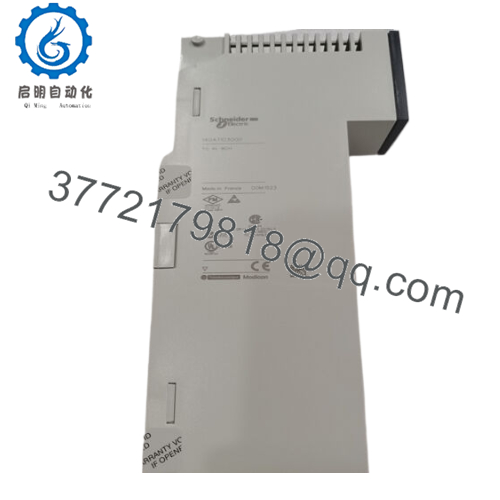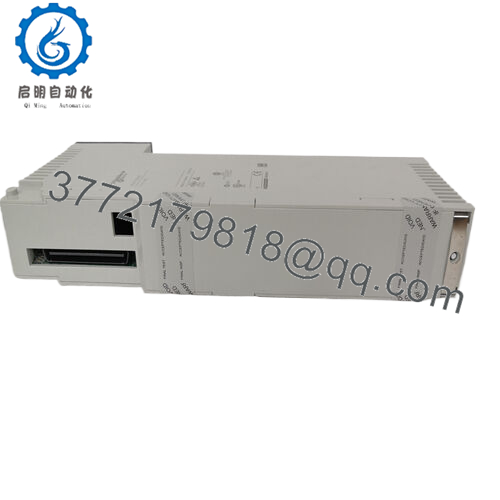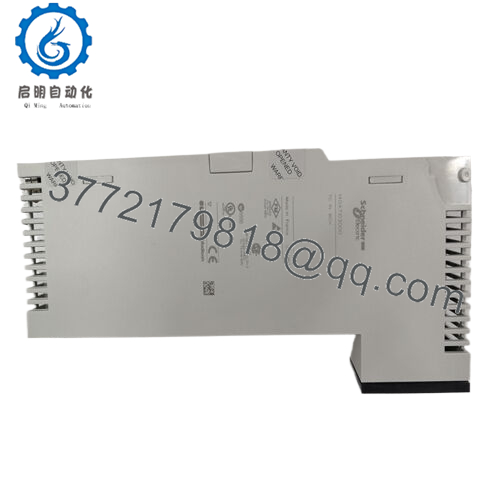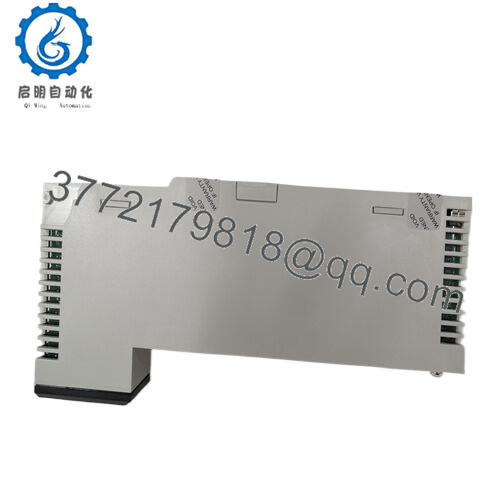Description
- Product Model: 140ATI03000
- Product Brand: Schneider Electric
- Product Series: Modicon Quantum
- Product Features:
• 8 analog input channels for thermocouples (types S, R, T, K, E, J)
• 16-bit resolution, internal cold junction compensation, and filtering (low-pass and 50/60 Hz notch)
• Isolation: 2,500 V DC (channel to bus), channel-to-channel isolation; low power consumption (~1.5 W)
• Discontinued (as of Jan 2023) with replacement recommendation (BMXART0814)
- 140ATI03000
Applications & Industry Context
In process industries—from petrochemical plants to power generation, food & beverage, or laboratory systems—temperature measurement is often among the most critical variables. The 140ATI03000 module is specifically designed to serve that need: reading thermocouples with precision and feeding that data to control logic or supervisory systems. Because thermal sensors drift, produce small millivolt signals, and are susceptible to noise, a robust module like the 140ATI03000 helps maintain data integrity.
Consider a chemical reactor where multiple zones of heating must be monitored in real time. The control system may require eight discrete thermocouple inputs to track temperature across several points. By installing 140ATI03000 in a Quantum I/O rack, engineers can centralize temperature sensing in a rugged, rack-based architecture. In water treatment or power plants, thermocouple-based instrumentation is common in boilers, exchangers, or sensor arrays; integrating those signals into the control network is where this module shines.
In retrofit scenarios, many older installations still rely heavily on TC sensors. Instead of replacing entire instrumentation suites, system integrators often drop in a 140ATI03000 module into the existing Quantum I/O fleet to bridge legacy sensors to updated control logic. Because the module’s form factor aligns with the Quantum family, it often fits without rework to backplane or rack layout.
Even though Schneider Electric marked 140ATI03000 as discontinued (effective 09 Jan 2023) and set its end-of-service date as 31 Dec 2030 the installed base remains large. Many plants maintain spares, and third-party refurbishers support this module class. The recommended replacement is Schneider’s BMXART0814, a low-level isolated analog input module (8 channels, ±40 mV) in the newer X80 line. For many users, migrating gradually (keeping 140ATI03000 until full system redesign) is the pragmatic path.
Product Role & System Fit
In a Quantum I/O rack, the 140ATI03000 is an analog input module, dedicated to reading thermocouple sensor signals. It does not generate outputs or digital I/O; instead, it converts raw millivolt levels from thermocouples into digital values for the CPU or logic modules to interpret. The module must live in a slot that has access to the rack’s analog I/O bus and must adhere to addressing rules (i.e. it requires 10 input words: 8 for the actual channels, plus status and temperature words)
During system configuration, the CPU (or controller software) maps those input words to temperature tags or feedback loops. Because each input is a genuine thermocouple type (S, R, T, K, E, J), the module needs to support cold-junction compensation internally and correct nonlinearity per thermocouple style.
When designing the control architecture, engineers often group similar sensor types, point count, and update rates to match control loop bandwidths. For slower processes (furnaces, ovens), a one-second update (1000 ms) is acceptable; 140ATI03000 uses that update window as standard.
Because the module draws bus current from the Quantum backplane (approx. 280 mA) and dissipates ~1.5 W, planners must include those loads in overall power budget and rack thermal design.
In migrating or hybrid systems, you might keep legacy 140ATI03000 modules for certain temperature zones, while newer analog modules (e.g. ±40 mV low-level types in the X80 line) serve newer sensors. Cross-mapping or scaling logic ensures consistency. The module is often a bridge in mixed systems.
Technical Features & Benefits
The 140ATI03000 stands out by combining precise thermocouple measurement capability with robust industrial isolation and noise handling. Here are key engineered strengths:
Channel & Thermocouple Support
It supports 8 independent thermocouple input channels, accepting common TC types (S, R, T, K, E, J) over wide temperature ranges (e.g. –270 °C to +1665 °C for some types). Each channel has 16-bit conversion resolution, enabling fine granularity in measurement.
Filtering & Noise Rejection
Because thermocouple signals are extremely small (microvolts to millivolts), the module includes a low-pass single-pole filter with a cutoff at 20 Hz and a notch filter tuned to 50/60 Hz to reject mains hum. This filter arrangement helps stabilize readings in electrically noisy environments.
Cold-Junction Compensation
The module performs internal cold-junction (reference junction) compensation across the ambient range (0–60 °C). This ensures that the thermocouple readings reflect the true temperature differential rather than ambient variance.
Isolation & Protection
To shield sensitive signals from interference and protect against ground loops, the 140ATI03000 offers strong isolation:
- Between channels and bus: 2,500 V DC for 60 seconds
- Between channels: 220 V AC / 300 V DC typical ratings
These isolations support safe, high-reliability installations in harsh settings.
Fault Diagnostics & Signaling
Each channel has an associated fault LED (red) to locally indicate wire breakage or out-of-range conditions. Corresponding green LEDs display channel alive indicators. A red external fault LED and a green bus communication LED provide system health visibility.
The module also detects “overtaking scale” conditions and broken-wire faults. These local diagnostics simplify commissioning and troubleshooting.
Power & Bus Load
The module draws about 280 mA from the Quantum backplane and dissipates 1.5 W under normal operation. It is relatively low-power, but in racks with many analog modules, cumulative heat must be managed.
Performance & Accuracy
Depending on thermocouple type, absolute accuracy is ±4 °C + 0.1% of reading for S/R types, and ±2 °C + 0.1% for T, K, E, J types. Linearity error is typically <1 °C (or <0.1 °C in tight ranges). Drift vs. temperature is specified at 0.15 µV/°C + 0.0015% of reading/°C (for low-level signals).
Update Rate
The module refreshes readings every 1000 ms (1 second) in normal operation, aligning with typical thermocouple-based control loop intervals.
Because the module is discontinued, spare management and firmware archives are critical. Schneider recommends BMXART0814 in the X80 line as a functional replacement for low-level analog measurement of similar channels.
Technical Specifications Table
| Specification | Value / Range |
|---|---|
| Module Type | Analog Input (Thermocouple) |
| Channels | 8 thermocouple inputs |
| Resolution | 16 bits |
| Supported Thermocouple Types | S, R, T, K, E, J |
| Cold-Junction Compensation | Internal (0–60 °C) |
| Filtering | Low-pass (−3 dB at 20 Hz) & Notch (−3 dB at 50/60 Hz) |
| Isolation | Channels ↔ Bus: 2,500 V DC (60 s) Between Channels: ~220 V AC / 300 V DC |
| Fault Detection | Broken-wire, over-scale conditions |
| Indicators | 8 × channel LEDs (fault/alive), external fault LED, bus LED |
| Addressing | 10 input words (8 data + status + internal temp) |
| Bus Current | Approx. 280 mA |
| Power Dissipation | ~1.5 W |
| Update Time | 1000 ms |
| Operating Temp | 0 to 60 °C |
| Storage Temp | –40 to +85 °C |
| Relative Humidity | Up to 95% (non-condensing) |
| Discontinued Date | 09 January 2023 |
| End-of-Service Date | 31 December 2030 |
| Recommended Replacement | BMXART0814 (Modicon X80 line) |
Installation & Maintenance Insights
When integrating a 140ATI03000 into a Quantum rack, adhere to best practices to ensure reliable performance:
- Slot Layout: Install near related analog or temperature zones so that thermal wiring trace lengths are minimized. Avoid placing it next to high-noise modules like power supplies or switching modules to reduce coupling interference.
- Wiring: Use twisted-pair, shielded wires (with shield grounded at one end) for thermocouple leads to reduce noise pick-up. Keep TC wiring runs as short as practical.
- Channel Pairing: When arranging channels, group similar thermocouple types together; this helps with calibration consistency and error tracking.
- LED Monitoring: During startup or commissioning, verify that all channel green LEDs indicate “alive,” and no red fault LEDs are lit. Use sensor simulation or loopback to test faulty-wire detection.
- Thermal Management: Because 1.5 W per analog module is dissipated, ensure the panel or rack has adequate ventilation to avoid excess ambient heat, which could stress module components over time.
- Spare Strategy: Given the module is discontinued, keep a matched spare 140ATI03000 unit (same revision, firmware) stored in controlled conditions. Also archive configuration and wiring diagrams.
- Replacement Planning: In long-term upgrades, migrate to the recommended replacement (BMXART0814) gradually. Be careful: differences in scaling or sensor interface may necessitate logic changes.
- Firmware & Revision Control: Although analog modules often have limited firmware changes, always record module revision codes and maintain firmware backups. This aids in diagnosing drift or compatibility issues.
One tip: before integrating into a live system, bench-test the module by applying thermocouple emulators (simulated millivolt signals) to each channel, and confirm data values map correctly in your control software. This pre-check helps avoid field rework.





 WhatsApp: +86 16626708626
WhatsApp: +86 16626708626 Email:
Email:  Phone: +86 16626708626
Phone: +86 16626708626


